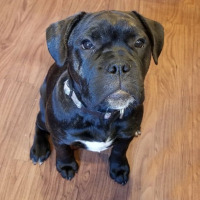Appearance of the French Masti-Bull
|
| The French Masti-Bull often resembles the Mastiff and is a very large breed. Some may be smaller, although both variants have large, deep jowls with wrinkles and folds on the face. Its head will be broad and square. A dark "mask" will be visible around their eyes and nose. The French Masti-Bull will have a robust, muscular body with a short, smooth, dense coat with colors including white, brown and black. The French Masti-Bull may have floppy ears like the Mastiff parent, or erect, bat-like ears like those of the French Bulldog. The tail can be long or short. Its size will depend on the parental mix and dominant genes. |
Temperament of the French Masti-Bull
|
| The French Masti-Bull is known as a good watchdog. He may intimidate some people, but in reality, they are usually gentle. However, early obedience training and socialization with strangers and other dogs is recommended. They are not generally barkers, but they are not calm dogs either. This hybrid can growl and snore, and may also sniff a little due to the stenotic nostrils typical of brachycephalic breeds like the French Bulldog. Sometimes stubborn and prone to being a little too laid-back, the Mastiff personality can be balanced with the feisty, on-the-go French Bulldog. |
Needs and activities of the French Masti-Bull
|
| Your French Masti-Bull will enjoy daily walks, and although he may be large, his exercise needs are not. A walk around the neighborhood to say hello to humans and dogs will suffice. He may agree to go to the dog park for a meeting. This hybrid should not be exercised in hot weather, so take a walk early in the morning, then again in cool weather. He can't live in an apartment simply because he's too big. This strolling dog will thrive with a secure enclosed yard to play in and a large house to stretch out in. |
Maintenance of the French Masti-Bull
|
| The French Masti-Bull has a short, smooth, dense coat that requires little maintenance. A weekly brushing with a smoother brush will be all that's needed to keep him looking dapper and well groomed. The folds and wrinkles on his face need to be cleaned and kept dry. The Mastiff is known to drool, and if your hybrid has this trait, skin care will be part of the maintenance routine. If there is any irritation or redness on your French Masti-Bull's face, consult your vet for care instructions. If the ears fold back, check them often for wax build-up or moisture. Teeth should be cleaned several times a week and nails trimmed twice a month. Train your French Masti-Bull from an early age to sit still during the nail-cutting process, as the older he gets, the bigger and harder the nails will be. Rewards for good behavior when he's young will make the grooming routine a breeze. |









 English (United Kingdom)
English (United Kingdom)